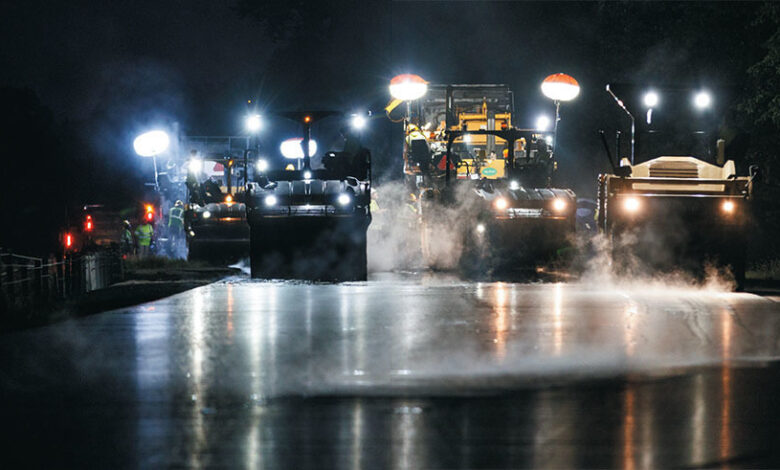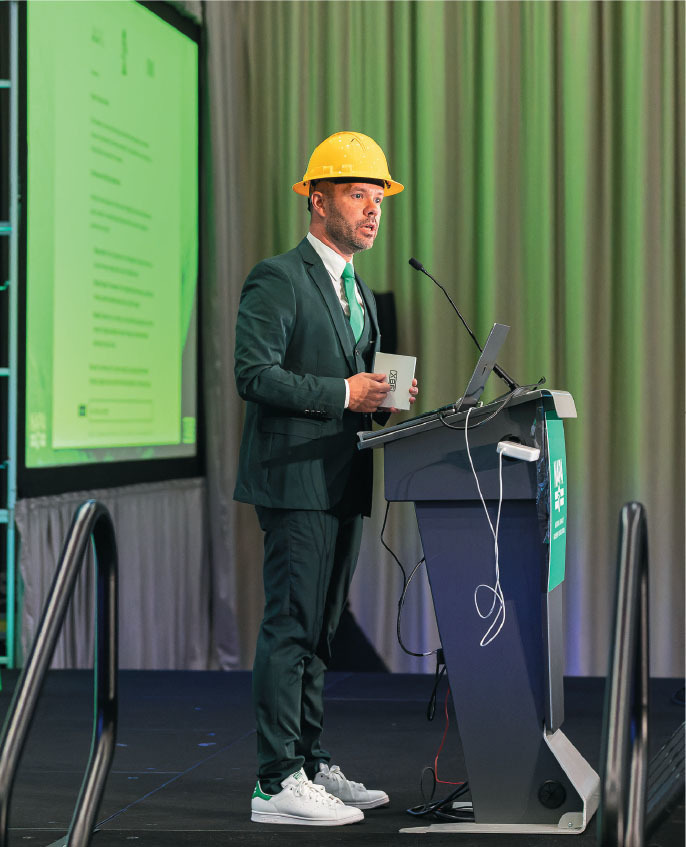Paving Beneath the ‘Blue Moon of Kentucky

Planning, echelon paving, and night crews finish I-71 work two days early
BY TY JOHNSON, MANAGING EDITOR
Mitigating lane closure times is a major part of interstate work, since factors ranging from weather to logistics can cause delays. But occasionally, everything comes together like clockwork, as with Interstate 71 in Kentucky where Louisville Paving Co. completed a resurfacing project days earlier than expected in September.
Louisville Paving Co. Director of Paving Operations Brian Bierman said the achievement was even more impressive coming from Project Manager Landon Blume, who started work at LP Aug. 8 and handled the planning and scheduling of the project.
“He was here for maybe two weeks and I dropped the book in his lap,” Bierman said. “He ran our largest job of the year in the paving division with a two-week heads up.”
Beginning Sept. 16, the Kentucky Transportation Cabinet asked motorists to prepare for a 10-day closure of the southbound lanes from the Watterson Expressway, or I-264, to I-265, also known as the Gene Snyder Freeway.
Bierman said working within a compressed schedule to resurface the 1.8-mile stretch of interstate presented the expected challenges, adding that the plan to get ahead of schedule and stay that way was the approach from the beginning.
“We adapted and made everything happen,” he said. “We’re used to that kind of work on the interstates.”
Bierman pointed out that to shave time off projects, every part of the operation has to do its part, including subcontractors. He lauded the quick and quality work of McCrite Milling crews, who milled 17,000 tons of materials within a 72-hour timeframe.
“Weeks of preparation goes into a time crush like that of 36 hours,” said McCrite Vice President Justin Glotzbach, who explained that roughly 60 employees were involved from the planning to execution stages. “Essentially, we worked around the clock with three machines the first night. Our guys came out and did a bang-up job. I was proud of our effort.”
Glotzbach called Louisville Paving a “fantastic partner” noting that “very few companies do projects the way they do,” with clear, thoughtful contingency plans.
“It’s always a pleasure to work with them on projects of this magnitude,” he said, adding that his company has partnered with Louisville on more than a half-dozen large projects. “We enjoy the big projects and big challenges.”
Bierman said the McCrite crews finished milling ahead of schedule, and then cleaned and prepped other portions of the road and bridge.
McCrite “was in getting us out there and for us to get started a shift ahead of schedule from what we had planned,” Bierman said. “There are always jobs where it looks good on paper, and this was one where it went the way we planned it.”
The full lane closures and subsequent motorist detours were necessary due to the narrow lane clearance on the southbound side of the interstate, Bierman said. Between the 12-foot lanes and three-foot shoulder, any traffic pattern that allowed for continuous traffic would mean motorists driving near a five-inch drop-off or cramming a guardrail into the already crowded space.
Another major hurdle to clear was providing enough drivers and trucks to support the work—more than 50 were used over the course of the project to move materials and equipment.
Once the milling was complete, Louisville crews moved to the job site to lay the base layer, but Sunday at 2 a.m. LP Vice President Matt Riggle, Bierman, and others were alerted to an electrical issue at one of their three asphalt production plants that ended up knocking it out of commission until Monday. By firing up the other facilities, however, operations lost only about 90 minutes of production.
“Our other two plants got us through Sunday night,” Riggle said, noting that proactive work on submitting designs at LP’s Bluegrass Testing Laboratory cut down on stress and time when they needed to pivot to keep the project on track. “We don’t have to scramble because all that stuff is done ahead of time.”
Riggle said larger projects mean planning for contingencies, especially when it comes to balanced mix design (BMD).
“High volume translates to a lot of work in the laboratory,” he said, noting that between the rutting, cracking, and volumetric tests, lab technicians are already working tirelessly to keep up. “We had them go ahead and compile for the entirety of the project. They really delivered on all those metrics that we look for.”
Riggle said temporary shutdowns, like the September pause of its 450 ton-per-hour plant, validate LP’s processes, which insist on backup plans. Bierman said all 33 pieces of equipment on the site—rollers, pavers, skid steers, and more—have a backup.
“We’ve learned that you have to have a backup for every backup,” Bierman said, noting that the second-string equipment and mechanics on site ensure that if there is a problem, it doesn’t take long to solve. “On a job this size, I don’t think you can overdo it.”
After the day crew laid half the base course, two night crews took over, although Bierman said operations continued through the shift change.
“The equipment never stopped,” he said.
But after the crew completed the base layer Monday night, the project faced four hours of downtime due to the discovery of what workers described as a “speed bump” in the base layer. Bierman did not know what it was when the call came in at 11 p.m., but by the morning it was revealed to be an original concrete slab that had shifted and popped up sideways, creating a mound in the layer that would need to be excavated.
Bierman said the dispatcher had the excavator and other equipment on site by 9 a.m. Tuesday to remove a section 18 inches deep, and by lunchtime they were filling the hole with base asphalt. Bierman said the logistics meant crews piloting the excavator were squeezing by on the shoulder due to the crews paving behind them. By about 3 p.m., the base area was laid and five hours later, after it had cooled down to specification, the night crew began paving the surface layer in echelon.
Although “the hard part was over” and some LP crews were sent to other projects, other workers on site installed the rock shoulders while subcontractors striped the road and placed reflective markers and rumble strips.
Saturday at 3:30 a.m., crews were removing construction barrels and by 6 a.m. the interstate was open to the public a full two days before expectations and just in time for Day Three of the Louder Than Life festival, which attracted more than 160,000 music fans to the Highland Festival Grounds in Louisville.
In Kentucky, delivering on rideability specifications is measured through a pavement smoothness scale. Riggle said the I-71 project completion meant a rideability improvement of 20 points.
“To do that that in a short timeline when everybody’s pushing production and to know that we can also deliver on quality is something to truly be proud of on our end,” Riggle said. “Public work is pretty tight there’s a lot of competitors bidding, and to be able to get the contract and win the project, you have to have that confidence in your team. We wouldn’t be able to win or bid these projects if we didn’t have confidence in our team members. It all comes down to execution at the end of the day.”




